Liquid Metallic Hydrogen
Liquid metallic hydrogen, which the planets Jupiter and Saturn are made of, is not an earthly substance. Even so, we might be able to get an idea of what it is from another substance, Mercury.
As shown in this picture, the element Mercury, at room temperature and at surface pressure, is a metallic liquid.
At temperatures and pressures within the giant planets, 10,000 degrees and thousands of times the pressure at sea level, the element hydrogen, which is normally a gas, becomes a metallic liquid. (It changes phase from a gas to a liquid).
Since the environment within a giant planet, of thousands of degrees in temperature, and extreme pressures, cannot be duplicated at earth at all, we may never be able to see liquid metallic hydrogen. But it may look very much like Mercury does in this picture.
You might also be interested in:
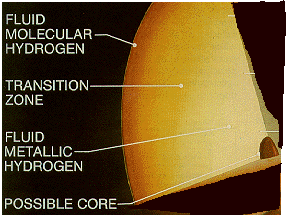
The first liquid layer inside Jupiter, immediately under the atmosphere, is the liquid hydrogen layer. The hydrogen atmosphere becomes thicker and thicker, a fog with more and more liquid hydrogen droplets,
...more
The first liquid layer inside Saturn, immediately under the atmosphere, is the liquid hydrogen layer. The hydrogen atmosphere becomes thicker and thicker, a fog with more and more liquid hydrogen droplets,
...more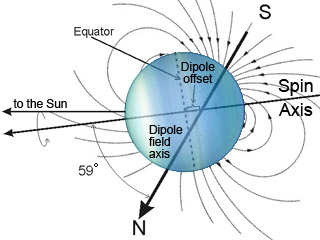
The planet Uranus has an odd magnetic field. The planet's magnetic poles are nowhere near the geographic poles (as defined by the spin axis) of Uranus. A portion of the magnetic field of Uranus is a dipole
...more
AU stands for Astronomical Units. Distances in space are too large to measure in Earth standards like miles or kilometers. For distances too large to measue in AU, we use light years. A light year is the
...more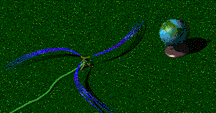
The solar wind is formed as the Sun's topmost layer blows off into space carrying with it magnetic fields still attached to the Sun. Gusts and disturbances form in the solar wind associated with violent
...more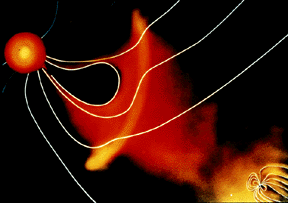
For a planet to be affected by a blob of material being ejected by the sun, the planet must be in the path of the blob, as shown in this picture. The Earth and its magnetosphere are shown in the bottom
...more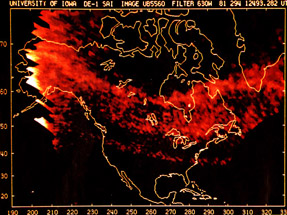
The aurora we are most familiar with is the polar aurora. This is what people are referring to when they speak of the northern or southern lights. But there are other less-known auroral activity, such
...more













